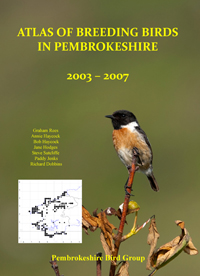Podiceps auritus
Sparse winter visitor.
The Slavonian Grebe breeds in both the Palearctic and Nearctic, mainly in the boreal climatic zone. Many move to coastal waters in the winter. The British breeding population is confined to Scotland and is too small to account for the number wintering in UK waters. It is likely that most winter visitors recorded are from the Continent.
Observers in the early days of recording in Pembrokeshire were probably as sparse as the grebe has proved to be. Consequently piecing together its true status was a slow and staccato affair, dependent on the growth of observer numbers. The pattern of occurrence was established by 1969, being confirmed by good continuous observer activity from 1983 onwards.

As can be seen from the above, the number visiting the county varied from year to year. How they were distributed throughout the year has been tabulated by summing all individuals for each month.

The April and May records refer to birds that had over wintered and departed late, in the case of the May birds, 2 at the Gann up to the 10th 1986, having achieved breeding plumage before leaving. The isolated July record was of a single bird seen on the Pembroke River on the 30th 1974. Otherwise the earliest return was of one at the Gann on the 9th October 1984.
Slavonian Grebes have most frequently been recorded in St Bride’s Bay, at various parts from Newgale to St Bride’s Haven, and within the Cleddau Estuary, principally at Angle Bay but also at the Gann and Pembroke River. They have been seen less frequently in most other parts of the Cleddau Estuary, as far upstream as Little Milford, and at several localities around the outer coast from Newport Bay to Tenby, twice in the Teifi Estuary, four times in the Nevern Estuary and eight times in Fishguard Harbour.
There are fewer records from fresh waters, viz. Trewellwell 23rd January 1929, Bosherston 1st February 1969, 20th & 27th December 1983, 1st – 27th January 1984, 15th January 1997, 13th February 1997, Llys y fran Reservoir 9th February 1985, 21st February 1987, 19th December 1993, Bicton Reservoir 8th – 21st March 1987 and Heathfield Gravel Pit 13th December 2002.
Graham Rees
(Covers records up to and including 2006)
 Tuesday, September 17, 2013 at 8:29AM
Tuesday, September 17, 2013 at 8:29AM 




